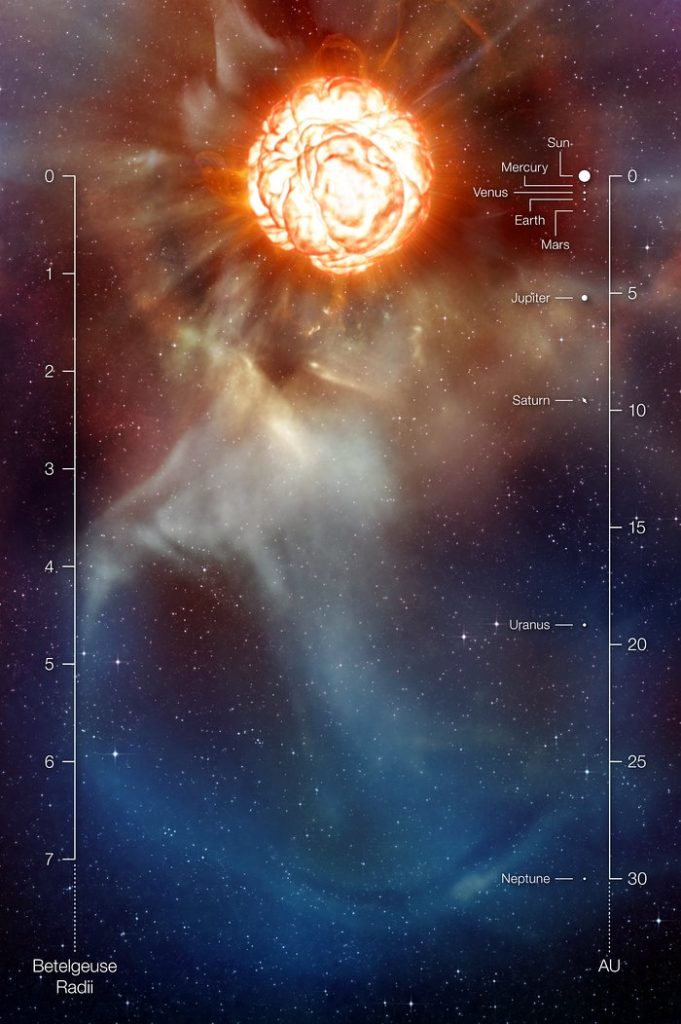
This artist’s impression shows the supergiant star Betelgeuse as it was revealed thanks to different state-of-the-art techniques on ESO’s Very Large Telescope, which allowed two independent teams of astronomers to obtain the sharpest ever views of the supergiant star Betelgeuse. They show that the star has a vast plume of gas almost as large as our Solar System and a gigantic bubble boiling on its surface. These discoveries provide important clues to help explain how these mammoths shed material at such a tremendous rate. The scale in units of the radius of Betelgeuse as well as a comparison with the Solar System is also provided.
Betelgeuse Is Still Dimming! And We Have the Pictures to Prove It
Fraser Cain | Universe Today
Near the end of 2019, astronomers watching the red giant Betelgeuse noted how much the star had dimmed, continuing to steadily fade for months.
It’s a variable star, and it’s known to get dimmer and brighter, but the big surprise is that it’s still continuing to dim, recently passing magnitude 1.56 and still getting dimmer. This is unprecedented in the decades that…
Beautiful Exposed Bedrock and Sand Dunes on Mars
Evan Gough | Universe Today
Impact craters can be quite complex. Depending on the size of the impactor, and on the size of the planet it strikes, craters form differently. Some form central peaks or uplifted structures, or even pits as seen in this image.
This image is the HiPOD, or the HiRISE (High Resolution Imaging Science Experiment) Picture of the Day. HiPOD’s are a selection of outstanding or particularly significant images of Mars from the…
Astronomers Simulated How the Universe Would Look Without Dark Matter
Matt Williams | Universe Today
Since the 1960s, there has been a general consensus among astronomers and cosmologists that the majority of the Universe is made up of an invisible, mysterious mass (known as Dark Matter). While scientists still haven’t identified the candidate particle that makes up this mass, indirect tests and simulations have shown that Dark Matter must exist in order for the Universe to be the way it is.
In a fascinating twist, a team of European researchers conducted a simulation that looked at a Universe without Dark Matter. Using an alternative theory known as MOdified Newtonian Dynamics (MOND), the team created a computer simulation in which the galaxies were actually very similar to what we see in the Universe today. These findings could help to resolve one of the most…
Mars Was Hit By a Lot of Protoplanets Early in its History, Taking Longer to Form than Previously Thought
Evan Gough | Universe Today
There are around 61,000 meteorites on Earth, or at least that’s how many have been found. Out of those, about 200 of them are very special: they came from Mars. And those 200 meteorites have been important clues to how Mars formed in the early Solar System.
We know that Mars was a very different place in the past. Mars’ oldest surfaces show signs of water, volcanic activity, and impact from planetesimals, which are defined as proto-planets up to about 1930 km (1200 miles) in diameter. But many of the clues to Mars’ formation are erased by…
The Pale Blue Dot: Now New and Improved
Nancy Atkinson | Universe Today
Thirty years have now passed since the Voyager 1 spacecraft snapped one of the most iconic and memorable pictures in spaceflight history. Known as the “Pale Blue Dot,” the heart-rending view shows planet Earth as a single, bright blue pixel in the vastness of space, as seen from the outer reaches of the solar system.
Now, NASA and the Jet Propulsion Laboratory have provided a new and improved version, using state of the art image-processing software and techniques to reprocess the thirty-year-old image. JPL software engineer and image processor Kevin Gill, whose images we feature…
The real reason SpaceX hired former top NASA official
Mark R Whittington | The Hill
Last summer it looked as if the long, celebrated career of Bill Gerstenmaier, NASA’s associate administrator in charge of human spaceflight, had reached a somewhat ignominious end. NASA Administrator Jim Bridenstine had removed Gerstenmaier from his post because it was felt that the man who had guided the shuttle, the ISS, commercial crew, and both the previous and current attempts to send astronauts back to the moon was ill-suited for guiding NASA’s effort to send the first woman and…
SpaceX Will Fly Four Tourists to Orbit in 2021-2022 on NASA Approved Crew Dragon
Brian Wang | Next Big Future
Space Adventures, Inc. and SpaceX will fly private citizens on the first Crew Dragon free-flyer mission.
This mission will be the first orbital space tourism experience provided entirely with American technology. Private citizens will fly aboard SpaceX’s fully autonomous Crew Dragon spacecraft launched by the company’s Falcon 9 rocket, the same spacecraft and launch vehicle that SpaceX will use to transport NASA astronauts to the International Space Station. NASA has approved that SpaceX crew dragon has met the loss of crew (LOC) requirement established by NASA at the beginning of the program. The LOC requirement is the odds of an accident killing or causing serious injury to a crewmember be no more than 1 in 270 flights for a 210-day mission at the International Space Station. This covers all aspects of…
SpaceX Plans Starship Gigafactories to Introduce the Hypersonic Age
Brian Wang | Next Big Future
SpaceX is planning Starship and Raptor engine gigafactories. In 2021, Elon Musk plans to scale the workforce at Boca Chica to 3,000 employees to eventually manufacture two SpaceX starships every week. There are currently 300 employees. This manufacturing rate will be comparable to the speed of construction of commercial wide-body airplanes.
Elon has said that mass production will bring the cost of the Starship down to $5 million. There will be six Raptor engines. This means the mass production of Raptor engines at less than…
Next Carnival of Spacer host is Universe Today!





































